



Upper left: Glossodoris atromarginata, Labrador; Upper right: Discodoris boholiensis, Sentosa;
Lower left: Chromodoris lineolata, Sisters Islands; Lower right: Hypselodoris infucata, Changi;
(Photos by Ria)
The name 'nudibranch' originates from a combination of the words nudus (Latin - naked) and brankhia (Greek - gills). Indeed, many species, like the four shown above, have a bushy tuft of external gills on their backs.
One of the most famous nudibranchs is the very large and colourful Hexabranchus sanguineus, a widespread species in the Indo-Pacific, although it is not recorded from Singapore waters.
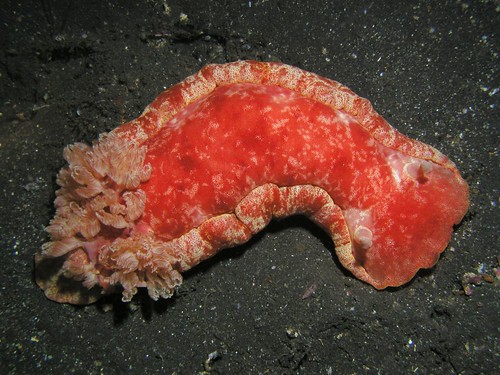
(Photo by Chika)
This species is commonly known as the Spanish dancer, for very obvious reasons:
FAMILY TIES
Nudibranchs are essentially a group of marine gastropods that have in the course of evolution lost their shells. Below are some of their close relatives:



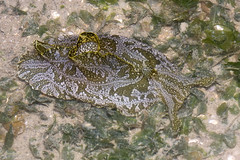
Upper left: zoned paper bubble shell, Hydatina zonata; Upper right: ornate leaf slug, Elysia ornata;
Lower left: moon-headed side-gilled slug, Euselenops luniceps; Lower right: geographic sea hare, Syphonota geographica;
(Hydatina by Chay Hoon, others by Marcus)
Not all of these nudibranch relatives have lost the shell; the zoned paper bubble shell and its relatives still possess a shell, whereas some of the sea hares retain a tiny shell that's partially or entirely enclosed within their soft bodies.
These various groups, together with the nudibranchs, usually fall under the generic term 'sea slugs'. However, despite their appearances, they are not at all closely related to terrestrial slugs. The onchidiid slugs commonly found on rocky shores and mangroves are actually close cousins of the land slugs that have successfully recolonised the seashore.
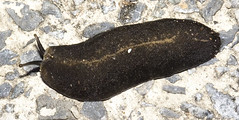

(Photos taken by Marcus)
WHAT DO NUDIBRANCHS EAT?
Nudibranchs are all carnivorous, and tend to be specialists; many species feed on only one particular prey species. Their diet usually consists of sessile organisms, which can't really run away from a prowling nudibranch. Animals as diverse as cnidarians, bryozoans, sponges, barnacles, and tunicates are food for various species of these brightly coloured slugs.

Here in Singapore, Jorunna funebris is believed to feed upon a certain species of blue sponge. (Photo by Ria)
One particular species of nudibranch from Florida (Aeolidiella stephanieae) is being cultured as an effective and reef-safe means of biological control against the glass anemone (Aiptasia spp.), an unwanted 'pest' species that can quickly reach plague proportions in a reef aquarium. These little nudibranchs are supposed to clear up glass anemone infestations, while leaving all other tankmates alone.
Other nudibranchs however prey on motile organisms.

The bizarre-looking Melibe has an expandable oral hood, which it uses to engulf small crustaceans.
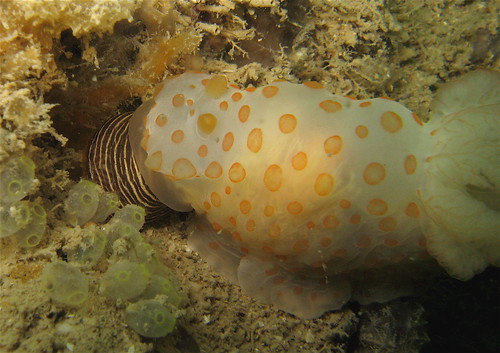
Some nudibranchs even prey on other nudibranchs! While diving at Pulau Hantu, Chay Hoon documented Gymnodoris rubropapulosa feeding on Chromodoris lineolata, and discusses her encounter here and here.

It appears that Gymnodoris are such voracious predators, they are even cannibalistic. (Photo by Ria)
Perhaps most interesting are the relationships that some nudibranchs have with zooxanthellae. Most would know how corals, among many marine organisms, form a symbiotic relationship with zooxanthellae, which are tiny single-celled dinoflagellates (otherwise known under the catch-all term of 'algae'). The zooxanthellae provide their coral hosts with energy through photosynthesis, while the coral provides shelter, nutrients and carbon dioxide for the zooxanthellae.
Some nudibranch species which feed on corals and other cnidarians are capable of keeping the zooxanthellae, which they ingest together with their prey, intact and alive. Others simply inadvertently ingest free-living zooxanthellae in the water. The zooxanthellae continue to grow, reproduce, and photosynthesise within specialised tissues in the nudibranch, and actually provide food for their new host!
Here are two local examples of such solar-powered slugs:

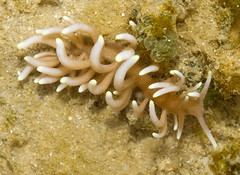
Left: Pteraeolidia ianthina feeds on hydroids; Right: Phyllodesmium briareum feeds on soft corals;
(Pteraeolidia by Ria, Phyllodesmium by Marcus)
These 2 species, among many others, possess fingerlike projections called cerata on their dorsal region. The zooxanthellae are stored within the cerata, and here they receive maximum exposure to sunlight. While the nudibranchs cannot survive indefinitely without feeding, this study has shown that starved individuals survive longer in constant sunlight than if they were kept in constant darkness, hinting that the zooxanthellae do help meet some of the nudibranch's nutritional requirements.
WHY ARE THEY SO COLOURFUL?
In the marine environment, being colourful is usually a form of advertising; in the case of the nudibranchs, which have poor eyesight and hence do not use their colours to attract mates, their bright coloration is a very clear signal to other marine creatures which might want to take a bite out of these soft-bodied molluscs: "Do Not Eat!"
Nudibranchs have evolved a wide array of defences. Some are well-camouflaged to blend in with the coral rubble:

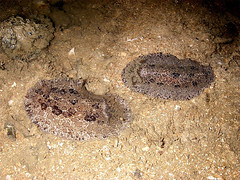


Upper left: Dendrodoris tuberculosa; Upper right: Discodoris lilacina;
Lower left:: Atagema spongiosa; Lower right:: Platydoris scabra;
(Dendrodoris by Siyang, Discodoris by Ron, Atagema and Platydoris by Ria)
Many species synthesis their own toxins, while others actually sequester chemicals found in their prey, which they then incorporate into their own bodies. What's interesting is that while some nudibranchs simply absorb and use the chemicals found in their prey, others actually metabolise chemical compounds in their prey, modifying these compounds into a more potent form. The result is that most nudibranchs are distasteful, even toxic; any fish that dares to take a nibble will soon learn to avoid repeating the act with other nudibranchs. The bright colours thus serve as a warning to potential predators.
Some species, such as the two Phyllidiella species shown below, can also release noxious chemicals into the water if disturbed.

Phyllidiella nigra (bottom, with purple tubercles) and Phyllidiella pustulosa (top, with blue tubercles)
(Photo by Ria)
The Sequestering of Secondary Compounds from Sponges by Nudibranchs
Some nudibranchs don't just absorb toxins from their prey, they actually 'borrow' the stinging cells found in their prey, and use these cells for defence!
These nudibranchs feed upon cnidarians such as sea anemones or hydroids, and the stinging cells (or cnidocytes) of their prey are actually passed to the cerata, undischarged, and stored within special sacs in the tips known as cnidosacs. The cnidocytes remain fully functional, firing away with tiny venom-filled barbs upon contact with another animal. Brushing against these nudibranchs can be just as painful as getting stung by the actual sea anemones or hydroids that these slugs feed on.


Cerberilla asamusiensis (left) and Cuthona sibogae (right) are some of those species that probably should never be handled with bare hands. (Cerberilla by Ron, Cuthona by Ria)
If you're interested in reading more about Singapore's nudibranchs, check out the following article at Singapore Celebrates our Reefs!.
Coming up, are nudibranchs suitable for aquariums?
This is part 2 of a 5-part series on nudibranchs, inspired by a feature article on nudibranchs on the National Geographic website.
Part 1: Nudibranchs are beautiful
Part 2: What is a nudibranch? (this post)
Part 3: Are nudibranchs suitable for aquariums?
Part 4: Nudibranchs for the aquarium
Part 5: Nudibranchs: Stowaways and Hitchhikers